Muralist Barbara Jo Revelle records Otocast audio that tells all about downtown ceramic tile mural
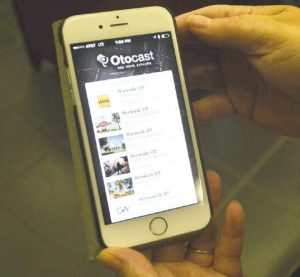 The City of Fort Myers is about to launch a free phone app that will enable users to learn about all the public artworks that are interspersed throughout the town. Called Otocast, the app contains text and historic photos for each covered artwork. But the app’s centerpiece is an audio recording made by the artist who created the piece or someone who is intimately familiar with the artwork and the stories it recounts. By virtue of this audio component, Otocast is like having your very own tour
The City of Fort Myers is about to launch a free phone app that will enable users to learn about all the public artworks that are interspersed throughout the town. Called Otocast, the app contains text and historic photos for each covered artwork. But the app’s centerpiece is an audio recording made by the artist who created the piece or someone who is intimately familiar with the artwork and the stories it recounts. By virtue of this audio component, Otocast is like having your very own tour 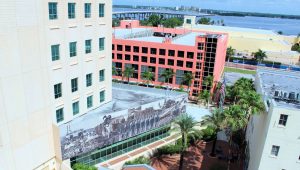 guide who knows the coolest facts and behind-the-scenes stories about the art pieces you see all around you.
guide who knows the coolest facts and behind-the-scenes stories about the art pieces you see all around you.
One of those artworks is the mural located on the federal building in the Hotel Indigo/Starbucks courtyard off First Street. Titled Fort Myers: An Alternative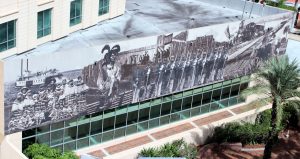 History, it was commissioned by the United States General Service Administration in 1997. Renowned photographer and muralist Barbara Jo Revelle was chosen for the project following a nationwide search.
History, it was commissioned by the United States General Service Administration in 1997. Renowned photographer and muralist Barbara Jo Revelle was chosen for the project following a nationwide search.
Rather than drawing additional attention to personages like  Thomas Edison and Henry Ford, Revelle decided that the story of our town’s true origins needed to be told in order to encourage greater inclusivity presently and in the future. The frontier
Thomas Edison and Henry Ford, Revelle decided that the story of our town’s true origins needed to be told in order to encourage greater inclusivity presently and in the future. The frontier 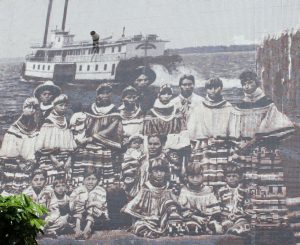 fort from which Fort Myers derives its name was built for the sole and exclusive purpose of deporting the last contingent of Seminoles from land guaranteed to them by a treaty entered into in 1842. Converted into a Union stronghold during the waning months of the Civil War, the fort was saved from total destruction at the hands of a homegrown Confederate cavalry unit by two companies of African American soldiers. Had the “Cow Cavalry”
fort from which Fort Myers derives its name was built for the sole and exclusive purpose of deporting the last contingent of Seminoles from land guaranteed to them by a treaty entered into in 1842. Converted into a Union stronghold during the waning months of the Civil War, the fort was saved from total destruction at the hands of a homegrown Confederate cavalry unit by two companies of African American soldiers. Had the “Cow Cavalry” 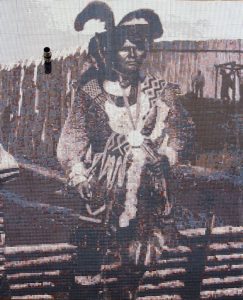 defeated the Union force in the Battle of Fort Myers, the fort would have been burned to the ground, thereby depriving the settlers who arrived a year later of the wood they needed to build their homes and trading posts. Mindful of the racial disharmony that existed in Fort Myers in the late 1990s, Revelle felt that blacks living in Dunbar and elsewhere in Southwest Florida could draw pride and satisfaction from the knowledge that the town owes its very existence to African Americans. (Revelle’s research also revealed that the fort was built with slave labor.)
defeated the Union force in the Battle of Fort Myers, the fort would have been burned to the ground, thereby depriving the settlers who arrived a year later of the wood they needed to build their homes and trading posts. Mindful of the racial disharmony that existed in Fort Myers in the late 1990s, Revelle felt that blacks living in Dunbar and elsewhere in Southwest Florida could draw pride and satisfaction from the knowledge that the town owes its very existence to African Americans. (Revelle’s research also revealed that the fort was built with slave labor.)
To Revelle’s enduring disappointment, the mural’s message was not well received. 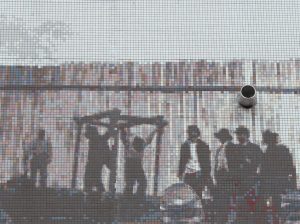 Not only was there no dedication ceremony following completion of the mural, the Guidebook that Revelle wrote to explain the history encapsulated by the mural was officially suppressed. Not even Revelle herself could get a copy of the printed booklet! And even today, modern accounts of our early history seek to whitewash our origins by ignoring or purging the fort’s true purpose, the federal
Not only was there no dedication ceremony following completion of the mural, the Guidebook that Revelle wrote to explain the history encapsulated by the mural was officially suppressed. Not even Revelle herself could get a copy of the printed booklet! And even today, modern accounts of our early history seek to whitewash our origins by ignoring or purging the fort’s true purpose, the federal 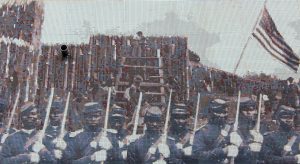 government’s role in instigating a war with Billy Bowlegs and his people when they refused to self-deport, and the part played by slaves in building the fort and African American Union soldiers in saving it from destruction in 1865. (See, e.g., Hidden History of Fort Myers by Cynthia Williams (History Press ©
government’s role in instigating a war with Billy Bowlegs and his people when they refused to self-deport, and the part played by slaves in building the fort and African American Union soldiers in saving it from destruction in 1865. (See, e.g., Hidden History of Fort Myers by Cynthia Williams (History Press © 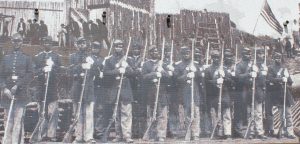 2017).)
2017).)
But now Ms. Revelle finally gets to tell the true story of her mural in an audio she has just recorded for Otocast – ending more than 18 years of silence. The audio is filled with interesting facts and little known anecdotes culled by the artist from 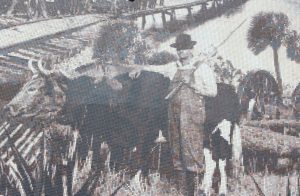 disparate source materials during the intensive research she conducted between 1997 and 1999.
disparate source materials during the intensive research she conducted between 1997 and 1999.
Revelle gained national notoriety in 1991 when she completed a photo-based, computer-generated tile mural on the Denver Convention Center that is two city blocks long. Titled A People’s History of Colorado, 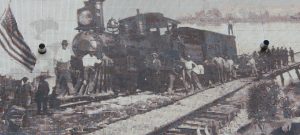 it is still one of the largest outdoor public art murals in the world. Between 1991 and 1997, Ms. Revelle went on to render murals on the new public library in Lafayette, Colorado, the clock tower that is part of the Safety and Justice Building in Longmont,
it is still one of the largest outdoor public art murals in the world. Between 1991 and 1997, Ms. Revelle went on to render murals on the new public library in Lafayette, Colorado, the clock tower that is part of the Safety and Justice Building in Longmont, 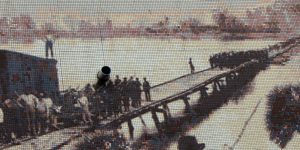 Colorado, and a documentary photo-mural for the Hancock Center, IBM Building and Uptown Hull House Gallery in Chicago that was sponsored by the Chicago Council of Fine Arts.
Colorado, and a documentary photo-mural for the Hancock Center, IBM Building and Uptown Hull House Gallery in Chicago that was sponsored by the Chicago Council of Fine Arts.
Prior to 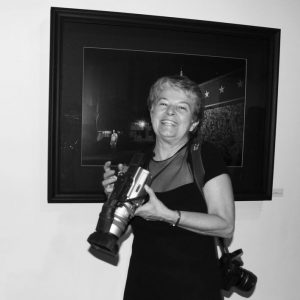 her retirement from teaching in 2011, Revelle served as a Professor and Director of the Photography Area of the University of Florida in Gainesville, where she had also served as Director of the School of Art and Art History between 1996 and 2000. Prior to that, she was director of the Photography and Electronic Media Program at the University of Colorado in Boulder for 13 years.
her retirement from teaching in 2011, Revelle served as a Professor and Director of the Photography Area of the University of Florida in Gainesville, where she had also served as Director of the School of Art and Art History between 1996 and 2000. Prior to that, she was director of the Photography and Electronic Media Program at the University of Colorado in Boulder for 13 years.
Over a span of more than 38 years, Revelle has taught art in many locations throughout the country, including San Francisco Art Institute, UCLA, 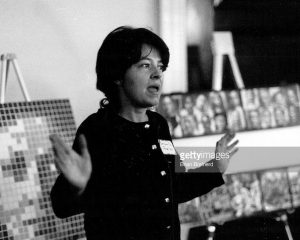 the University of Colorado in Boulder, The School of the Art Institute and The Institute of Design in Chicago, Arizona State University, N.Y. State University College in Buffalo and the Rhode Island School of Design in Providence.
the University of Colorado in Boulder, The School of the Art Institute and The Institute of Design in Chicago, Arizona State University, N.Y. State University College in Buffalo and the Rhode Island School of Design in Providence.
Revelle has exhibited nationally and internationally in more than 35 individual and 130 group shows in New York, Chicago, San Francisco, Los Angeles, Japan, Mexico, Germany, France, Sweden, Australia 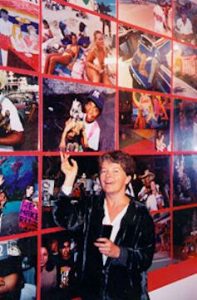 and England. Her work is owned by 41 public collections here and abroad including the San Francisco Museum of Modern Art, the International Museum of Photography at George Eastman House in Rochester, New York, Revelle 06the Bibliotheque National in Paris, the Eikoh Hosoe Collection in Tokyo, the Museum of Modern Art in Stockholm and the Victoria and Albert Museum in London. Her work has received critical acclaim in Art Forum, Z Magazine, Ten/8, Art Week, Afterimage, the New Art Examiner and a host of other journals, as well as many important books including Contemporary Art and Multicultural Education published by Routledge with the New Museum of Contemporary Art. Revelle has been the recipient of 31 grants and fellowships including a major NEA.
and England. Her work is owned by 41 public collections here and abroad including the San Francisco Museum of Modern Art, the International Museum of Photography at George Eastman House in Rochester, New York, Revelle 06the Bibliotheque National in Paris, the Eikoh Hosoe Collection in Tokyo, the Museum of Modern Art in Stockholm and the Victoria and Albert Museum in London. Her work has received critical acclaim in Art Forum, Z Magazine, Ten/8, Art Week, Afterimage, the New Art Examiner and a host of other journals, as well as many important books including Contemporary Art and Multicultural Education published by Routledge with the New Museum of Contemporary Art. Revelle has been the recipient of 31 grants and fellowships including a major NEA.
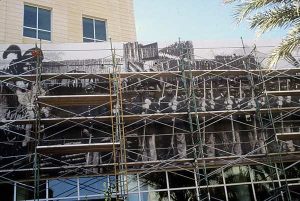 Although Fort Myers: An Alternative History is not part of the City of Fort Myers’ public art collection, the City’s Public Art Committee has opted to include it in its Otocast roll-out because of its location and the contribution it makes in recounting the early history of our town.
Although Fort Myers: An Alternative History is not part of the City of Fort Myers’ public art collection, the City’s Public Art Committee has opted to include it in its Otocast roll-out because of its location and the contribution it makes in recounting the early history of our town.
For more information on this mural, read here. 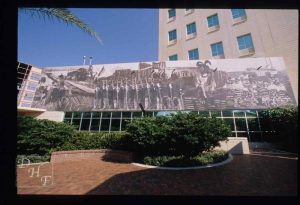 For more information on the other artworks located throughout Fort Myers, please visit culturenow.org, the Public Art Archive and FortMyersPublicArt.com or pick up a copy of The City of Fort Myers Public Art Collection brochure at City Hall. For more on Naiad, read here, or wait until the app goes live.
For more information on the other artworks located throughout Fort Myers, please visit culturenow.org, the Public Art Archive and FortMyersPublicArt.com or pick up a copy of The City of Fort Myers Public Art Collection brochure at City Hall. For more on Naiad, read here, or wait until the app goes live.
[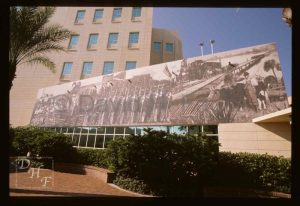 EDITOR’S NOTE: In the interest of full disclosure, this author serves as the City of Fort Myers Public Art Consultant. However, this post is written solely in my capacity as an art journalist, advocate and blogger. The opinions presented above are my own and in no way reflect the views of the City of Fort Myers, Fort Myers Public Art Committee or any member thereof.]
EDITOR’S NOTE: In the interest of full disclosure, this author serves as the City of Fort Myers Public Art Consultant. However, this post is written solely in my capacity as an art journalist, advocate and blogger. The opinions presented above are my own and in no way reflect the views of the City of Fort Myers, Fort Myers Public Art Committee or any member thereof.]














 Tom Hall is both an amateur artist and aspiring novelist who writes art quest thrillers. He is in the final stages of completing his debut novel titled "Art Detective," a story that fictionalizes the discovery of the fabled billion-dollar Impressionist collection of Parisian art dealer Josse Bernheim-Jeune, thought by many to have perished during World War II when the collection's hiding place, Castle de Rastignac in southern France, was destroyed by the Wehrmacht in reprisal for attacks made by members of the Resistance operating in the area. A former tax attorney, Tom holds a bachelor's degree as well as both a juris doctorate and masters of laws in taxation from the University of Florida. Tom lives in Estero, Florida with his fiancee, Connie, and their four cats.
Tom Hall is both an amateur artist and aspiring novelist who writes art quest thrillers. He is in the final stages of completing his debut novel titled "Art Detective," a story that fictionalizes the discovery of the fabled billion-dollar Impressionist collection of Parisian art dealer Josse Bernheim-Jeune, thought by many to have perished during World War II when the collection's hiding place, Castle de Rastignac in southern France, was destroyed by the Wehrmacht in reprisal for attacks made by members of the Resistance operating in the area. A former tax attorney, Tom holds a bachelor's degree as well as both a juris doctorate and masters of laws in taxation from the University of Florida. Tom lives in Estero, Florida with his fiancee, Connie, and their four cats.